The 50 Best Horror Movies Of All Time
Can you survive them all?
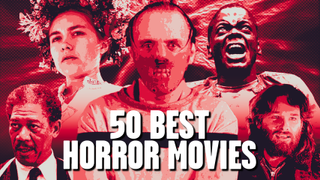
As is the case with many other genres of film, horror has been explored in various ways, some more frightening than others. The films have followed trends and influences, and perhaps most importantly, have continued to evolve over the course of movie history. With that in mind, while putting together the ultimate list of the fifty best horror movies of all time, we worked together to select and order the best of the best in scary cinema, factoring in some of the best zombie movies, the best movies about demonic possession, A24’s terrifying horror films and more. In the end, so much of what makes horror an evolving, entertaining and thrilling genre is represented in the movies on this list. While we’re excited to see what upcoming horror movies might find a spot on this list at some point in the future, let’s settle in, brace ourselves for a jump-scare or two, and take a look back at some of the best horror movies of all time…
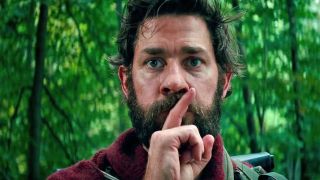
50. A Quiet Place (2018)
Who would have thought that if Jim Halpert and Mary Poppins teamed up, they’d create one of the best horror movies of the last decade. Directed by John Krasinski, who also has a writing credit on the blockbuster sci-fi/horror film, A Quiet Place crushed when it premiered at SXSW in 2018 and continued to do so when at the box office. Starring Krasinski and Emily Blunt, who are also married in real life, the film makes amazing use of both sound, which it mostly keeps to a minimum, and silence to showcase a beautiful and terrifying combination of Horror and Drama…and aliens.
With an awesome sequel already in the franchise and A Quiet Place prequel ready to launch in 2024, there’s a good chance this franchise will go down in history as a classic that is remembered and rewatched by Horror fans for decades to come.
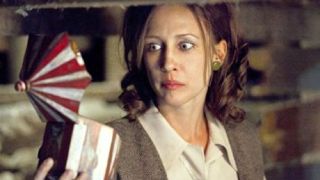
49. The Conjuring, The (2013)
Kicking off a franchise of films based on the case files of Ed and Lorraine Warren, director James Wan’s The Conjuring is a horror film existing in the tradition of being “based on true events.” As we watch Patrick Wilson and Vera Farmiga’s cinematic incarnations of those real-life paranormal investigators, we can sink into the drama of a good movie, while also being motivated to research more into the actual happenings. Skeptics and believers alike can enjoy this movie in their own way, as the scares are as effective as Wilson and Farmiga’s chemistry with each other, and the family they’re trying to aid.
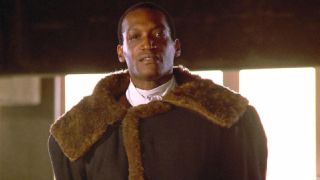
48. Candyman (1992)
It should come as no surprise that 1992’s grim and grisly Candyman was based on a short story written by Clive Barker, the genre master responsible for Hellraiser and many other disturbing works. But the socially charged folklore horror tale, which co-starred Virginia Madsen and Xander Berkeley, is best remembered not for its source material, or for the film’s director Bernard Rose, but for the unmatchable terrifying performance from star Tony Todd as the vengeful antagonist. Candyman is possibly the only fictional character to be intrinsically attached to bees who is far more frightening than the bees themselves. And despite being unmistakably a ‘90s movie, Candyman remains one of the more effective racially driven horror movies of the 20th century.
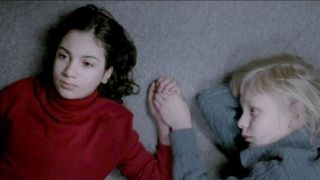
47. Let The Right One In (2008)
There is a lot that is unassuming about Tomas Alfredson’s Let The Right One In. Based on the book of the same name by author John Ajvide Lindqvist, the movie’s quiet, snowy Swedish setting provides a serene atmosphere, and there is great sweetness in the relationship between the young, meek Oskar (Kåre Hedebrant) and Eli (Lina Leandersson), the mysterious girl who moves in next door. But when the film reveals its vampire teeth and bites, it’s ferocious and spectacular. This shocking contrast is part of what makes it a special entry in the canon of vampire lore and one of the best horror films of the 21st century.
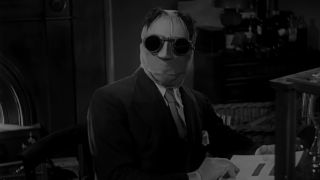
46. The Invisible Man (1933)
“How the hell did they do that?!” That’s a phrase one finds oneself asking many times while watching director Frank Whale’s classic The Invisible Man. Nowadays, a lot of on screen fantasy is computer generated, but this is a film made of pure movie magic – the classic example being the titular protagonist unwinding the gauze covering his head and revealing… absolutely nothing. In addition to its astounding effects, it spins a tremendous mad scientist tale that is anchored by an iconic performance by Claude Rains as the notorious Dr. Jack Griffin. More than just part of the Universal Monsters, it’s a landmark achievement in the history of the horror genre.
CINEMABLEND NEWSLETTER
Your Daily Blend of Entertainment News
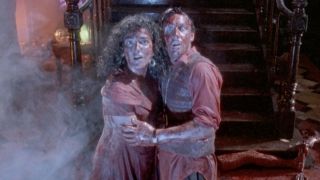
45. Dead Alive (1992)
Today, Peter Jackson is best known as the filmmaker who spent years and years crafting the most faithful J.R.R. Tolkien adaptations possible – but focusing wholly on those years is ignoring the brilliant start of his career when he made some of the most insane genre films of the 20th century. His crowning achievement during this era is 1992’s Dead Alive, also known as Braindead. It’s a wild, gory, and ridiculous horror feature, and the levels of creativity are mind-blowing. The whole movie is made of demented brilliance, but the third act in particular is a master’s course in genius, practical horror effects, with highlights including a man getting his face torn off his skull, a woman getting her heart ripped out of her chest, and a lawnmower being used to kill dozens of zombies.
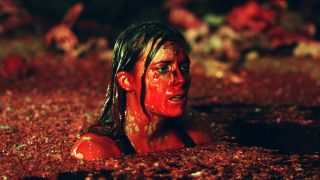
44. The Descent (2005)
The idea of being trapped in an unexplored, underground cave with hungry, nocturnal mutants is certainly terrifying, but not particularly relatable. Something that many audiences can identify with, however, is the loss of a loved one and the uphill battle to overcome such a tragedy. Writer and director Neil Marshall masterfully fused these otherwise disparate concepts into one unspeakably horrifying downward spiral into madness that follows Sarah (Shauna Macdonald) reuniting with her friends a year after losing her husband and daughter for a caving expedition that goes terribly wrong. By treating its deadly labyrinth setting as metaphor for the central character’s seemingly inescapable pain, The Descent is a horror movie that addresses grief in truly profound and indelible ways — qualifying it as one of the best horror movies of the 2000s, easily.
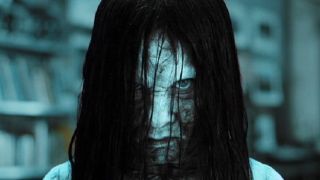
43. The Ring (2002)
As a glossy horror movie produced in the post-Blair Witch Project era that hinged entirely on videotapes just as the medium was becoming irrelevant, The Ring had plenty of chances to be a complete failure, and the fact that it was an Americanized adaptation of the lauded J-horror feature Ringu didn’t help its chances. And yet screenwriter Ehren Kruger, director Gore Verbinski, and star Naomi Watts combined forces for a successfully haunting and tech-driven version of the chain letter, with this approach offering up an inexplicably hair-raising stream of seemingly random imagery as its doomladen pass-along footage. As downright frightening as Samara is, though, the images most burned into my brain are the shock-monster visages of her curse-laden victims.
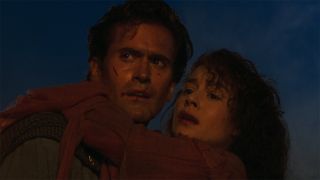
42. Army of Darkness (1992)
The third feature in Sam Raimi’s Evil Dead-verse, Army of Darkness is technically the story the filmmaker wanted for the first sequel, but its blood-soaked time-travel shenanigans were not the studio’s ideal at the time. Thankfully, Bruce Campbell’s Ash Williams was able to teach the Middle Ages all about whooping deadite asses when the film was released in theaters in 1993. Adhering to the absolutely correct idea that Ash’s best enemy is always another version of himself, Army of Darkness veers wildly between modes and moods, with much of the basement-monster tension and horror giving way to more kinetic action sequences and effects-driven mayhem. But appreciation for its off-kilter approach has only grown in the years since, especially as other Evil Dead projects have largely maintained the haunted single locale arc.
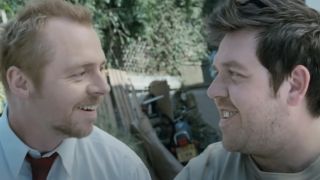
41. Shaun Of The Dead (2004)
The holy union of Simon Pegg and Edgar Wright began on the small screen with Spaced — a hit U.K. sitcom that thrived on inventively humorous editing and unique allusions to pop culture. The duo would maintain that formula to craft a new take on the genre pioneered by George A. Romero that, unlike many horror-comedy movies at the time, is as funny as it is genuinely scary. Pegg stars as the title character of Shaun of the Dead — an aimless electronics store employee forced to grow up and try to protect his loved ones when London becomes overrun with flesh-eating, reanimated corpses. Mix in pop culture appreciation and appearances from a host of beloved UK thesps, and this hilarious creature feature still manages to be one of the most heartbreaking and realistic zombie films of all time.
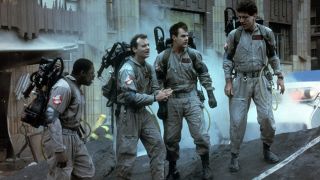
40. Ghostbusters (1984)
Threading the needle between horror and comedy can be difficult. Are you making a scary movie that’s occasionally funny, or a funny movie that boasts scares? Ghostbusters leans into its laughs – as you might expect from a movie built around Bill Murray, Dan Aykroyd, and Harold Ramis. But director Ivan Reitman didn’t pull any punches when it came to the supernatural side of his 1984 blockbuster, and caught audiences off guard with a terrifying library ghost, two vicious hell hounds, and the ominous threat of Gozer (Slavitza Jovan). Mind you, the Ghostbusters fought a skyscraper-sized marshmallow man, but this movie has more than enough scares to earn it a spot on our list.
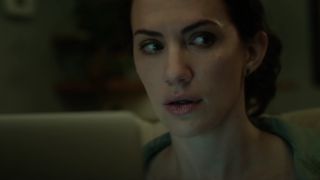
39. Hush (2016)
Hush is one of the best horror movies from the last ten years, yet gets discussed among the least. Its quality shouldn’t be surprising, as it was directed and written by genre auteur Mike Flanagan prior to his work on highly acclaimed shows like The Haunting of Hill House. The concept is simple: a home invasion slasher where protagonist novelist Maddie (played by co-screenwriter Kate Siegel) is forced to defend herself. But there’s a twist, Maddie is a deaf-mute living in isolation in the woods.
Maddie being deaf both informs her character choices, and makes the horror action of the movie infinitely more thrilling and interesting, as the audience is able to hear The Man (John Gallagher Jr.) coming in moments where Maddie cannot. Lore fans should keep an eye out for Maddie’s acclaimed novel, which is an in-universe easter egg for another Flanagan series.
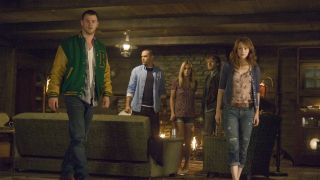
38. Cabin In The Woods (2012)
While the horror genre as a whole is a fun ride, there's a special magic with projects that pivot between scares and comedy. Joss Whedon’s The Cabin in the Woods is definitely in that category, and takes a meta look at the genre as a whole. And the results make it a modern horror classic.
The film follows a group of friends, who decide to vacation in (you guessed it) cabin in the woods. As we follow typical horror tropes, it soon becomes clear that there’s a secret organization manipulating the friends into playing their roles and dying in quick succession. The movie’s third act is a truly bonkers ride, complete with a shocking ending. And the cast includes a pre-Thor Chris Hemsworth, as well as Bradley Whitford, Grey’s Anatomy star Jesse Williams and more.
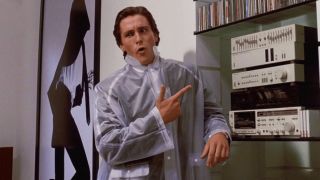
37. American Psycho (2000)
Five years before audiences embraced him as Christopher Nolan’s Batman, Christian Bale took on one of the only two horror roles in his career as Patrick Bateman, the hyper-slick and disturbed investment banker at the heart of Mary Herron’s American Psycho. Based on the already stellar novel from Bret Easton Ellis, the adaptation would presumably still be an excellent character study even without the sporadic moments of madcap violence, horror, and deep appreciation for Huey Lewis and the News. But those moments are there in full, and the combination is effective enough to produce levels of wavering sympathy for Patrick, even if he never stops being a total asshole to his fellow investors. The film’s ambiguous ending doesn’t need to be answered to make an impact, since something is very wrong with Bale’s character no matter how you slice it.
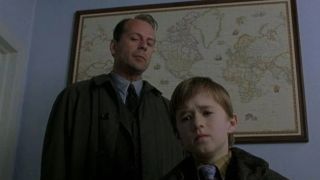
36. The Sixth Sense (1999)
“I see dead people.” Four words that still make the hairs on the backs of our necks stand at attention. Haley Joel Osment is scary good as Cole, the haunted boy struggling to fit in at school who guards a crucial secret from Dr. Malcolm Crowe (Bruce Willis), the therapist who has been hanging around. Cole sees ghosts… and sometimes even helps them to accomplish something they weren’t able to do before they died. The Sixth Sense was a monumental success in 1999, breaking multiple box-office records behind the power of positive word-of-mouth recommendations, and is now considered on of the best '90s movies. The film even nabbed six Academy Award nominations – and should have earned Osment a win in the Best Supporting Actor category. No matter how many movies M. Night Shyamalan goes on to make, this one forever will remain one of his best.
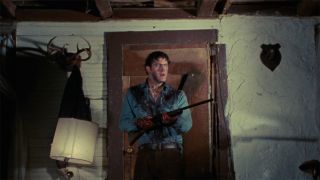
35. The Evil Dead (1981)
A lot of horror movies from yesteryear could be deemed “tame” by today’s standards, but Sam Raimi’s first major venture into horror, The Evil Dead, isn’t one of them. Starring Bruce Campbell in his breakout role, The Evil Dead features brutal violence, grisly makeup and effects, and… Well, if you’ve seen it before, then all we have to really say is: “Watch out for the trees.” It may not be the greatest Evil Dead movie of all time — mostly because it’s more of a straight-up horror flick and lacks the comedic elements of Raimi’s other Ash-fronted projects — but when it comes to scary movies set in the middle of the woods, you’d be hard-pressed to find a more legendary option than the one that started the deadites’ reign of terror.
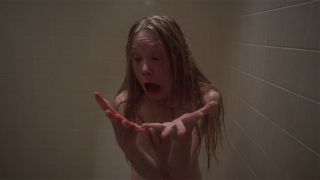
34. Carrie (1976)
The works of Stephen King have inspired some of the most iconic horror movies and series of all time, and Carrie is the film that started it all. Based on King’s debut novel of the same name, the movie follows Carrie White’s journey as she changes from frightened teenage girl to a telekinetic killer, but with enough nuance to raise the question: who is really the villain in the story? Sissy Spacek’s Carrie may have been the one coated in pig blood while committing that climactic rampage, but Piper Laurie’s tyrannical Margaret White as well as Nancy Allen’s Chris Hargensen (and John Travolta’s breakout role as Billy Nolan) are equally excellent candidates for the big bads of the story. Carrie also cemented Brian De Palma as a must-watch director, and features one of the genre’s most influential endings.
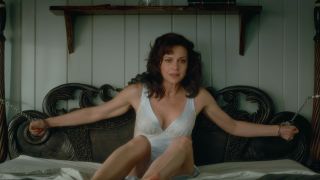
33. Gerald's Game (2017)
There are a number of Mike Flanagan projects on this list, as he’s become an acclaimed source for horror content — both films and TV — such as the Netflix original film Gerald’s Game. An adaptation of Stephen King’s novel of the same name, the movie stars Flanagan regular Carla Gugino as protagonist Jessie, who joins her husband Gerald on a trip to their remote cabin for a romantic getaway. He insists on handcuffing her to the bedpost for some kinky sex, but disaster strikes when he suddenly has a heart attack and collapses, with Jessie left all alone to find a way to survive. It’s a movie that leans into stranded and semi-claustrophobic feelings of helplessness, with Jessie having conversations with herself that reveal traumatic flashbacks as the story unfolds. The final moments are not for those who get queasy easily, but it’s a perfectly paced horror flick that once again proves that Flanagan knows his way around a horror project, whether it’s set in a giant mansion or a small cabin bedroom.
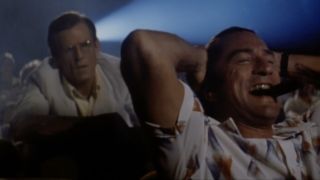
32. Cape Fear (1991)
Cape Fear is a deeply unsettling story of betrayal and revenge. It’s filled with characters that have deep personal flaws, and uses those characters to ask a lot of morally complicated questions about our criminal justice system. A lesser director would probably attempt to answer those questions directly, but Martin Scorsese lets his characters grasp at them without relief. That uneasy fumbling builds tension, and as more personal betrayals come to light, it all simmers and finally boils over in a climax that’s as vicious as any of the gorier entries on this list, and with a monster that’s only too human in nature.
Cape Fear is awash with terrific acting performances and bold artistic choices. It’s far from a traditional horror movie, but because of that originality, it’s able to terrify in its own disturbing and unique ways.
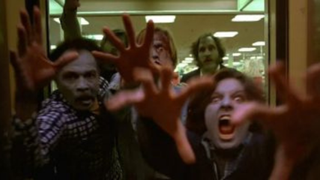
31. Dawn Of The Dead (1978)
George A. Romero is the godfather of zombie movies, period, full stop. Using the horror genre to bittersweetly satirize and comment on modern society, his Dead films are still pinnacles of using exaggerated terror to dig into the all too real dread of everyday life. In Dawn of the Dead, consumerism is the sacred belief of American life that’s being lambasted, with zombies returning to their familiar stomping grounds of the mall being the ultimate statement.
As influential as it is amusing, Dawn of the Dead pushed George A. Romero’s filmmaking and storytelling style further after landing an iconic hit with 1968’s Night of the Living Dead. While not consistent in its release timeline, the director has always given fans a reason to show up when a new film bearing the name “...of the Dead” made its way to theaters.
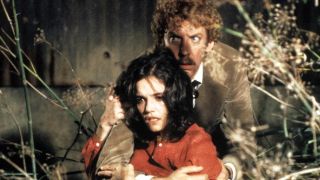
30. Invasion Of The Body Snatchers (1978)
The second adaptation of Jack Finney’s 1955 novel – and easily the most effective – Philip Kaufman’s 1978 film Invasion of the Body Snatchers is arguably the greatest “pod people” feature in all of sci-fi horror. Starring genre vets Donald Sutherland, Brooke Adams, Jeff Goldblum and more, the movie’s titular invasion is sourced to alien parasites that appear as flowers, making it easier to believe that just about anyone could fall victim to the unfamiliar species. The film’s success can be applied to a multitude of winning elements, including the expanded themes of identity, humanity and paranoia, with Kaufman ratcheting up the tension and disquiet to dizzying heights. Not to take away from the exquisite sound mixing, the stellar performances, and the twist ending. Few film stills will ever invoke the same amount of dread as Sutherland’s Matthew Bennell pointing and screaming.
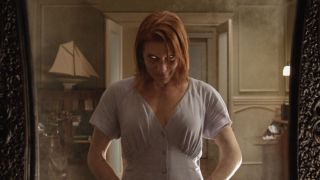
29. Oculus (2013)
Anyone who just adores antique mirrors will possibly feel very differently after watching Mike Flanagan’s trauma-soaked frightfest Oculus, itself based on the filmmaker’s 2005 short film. The first feature to introduce the cursed Lasser Glass to horror fans, Oculus stars Karen Gilan and Brenton Thwaites as siblings Kaylie and Tim, who reunite as adults years after a largely unexplainable childhood tragedy split them apart. The narrative takes place across two different timelines that occasionally mash together, with Katee Sackhoff and Rory Cochrane in their most disturbing roles as Kaylie and Tim’s parents in the 2002 flashback. Oculus is where Flanagan really honed his chops and developed several of his signature flairs -– from extended one-shots to A+ supernatural effects to mood-cementing music from The Newton Brothers — that would go on to populate his Netflix TV fare like the Haunting of Hill House and The Fall of the House of Usher. And it will always be the movie that reminds viewers to make sure the apple they’re eating isn’t actually a light bulb.
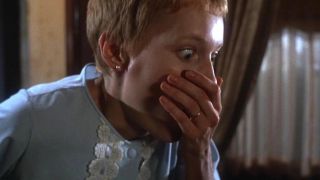
28. Rosemary's Baby (1968)
While some films have become iconic within one particular subgenre of horror, Rosemary’s Baby combines psychological chills with supernatural frights to a chilling degree that has helped keep the story relevant despite the more than half century passing since it was released. A surprisingly faithful adaptation of Ira Levin’s book of the same name, Mia Farrow carries the film as the titular Rosemary, and she sells what might have otherwise felt like a ridiculous ending with a reveal much more outlandish than just witchcraft. Her pregnancy story alone could have been enough for a full horror film; add the Satanic bent and John Cassavetes, Ruth Gordon, and Sidney Blackmer as Farrow’s co-stars, and Rosemary’s Baby stands the test of time.
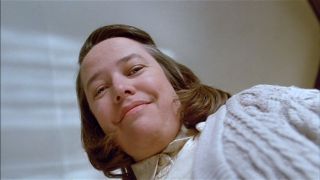
27. Misery (1990)
Stephen King is one of the most brilliant minds in horror, and one of his most acclaimed works remains the suspenseful character study Misery, a novel that trades out supernatural frights and otherworldly creatures for a story steeped in the depths of human atrocities. So it’s no surprise that its adaptation, helmed by Stand By Me director Rob Reiner, went on to become the only Academy Award-winning film based on one of King’s works, thanks to the exquisitely unnerving performance from Kathy Bates as the hopelessly devoted Annie Wilkes.
An avid reader obsessed with a character created by James Caan’s romance novelist Paul Sheldon, Annie takes matters into her own hands when Sheldon’s stories take an unwanted turn. Misery is one of those horror movies where it doesn’t aim to creep you out with gore, but with unhinged performances and excellent storytelling. Anybody could destroy someone’s foot with a mallet, but no one can play Annie like Kathy Bates.
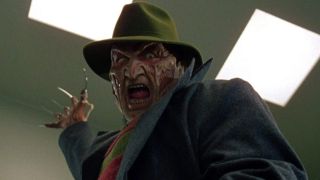
26. Wes Craven’s New Nightmare (1994)
As the titular Freddy Krueger creator’s final tango with the Elm Street franchise, Wes Craven’s New Nightmare is a natural forefather to Scream, taking a more serious and sinister approach with the conceit of “What if real life turned into a horror movie?” The franchise-honoring sequel stars A+ scream queen Heather Langenkamp in a fictionalized version of her life, with Pet Sematary’s Miko Hughes as her haunted son, as well as genre icon Robert Englund playing both himself and a more minacious and malicious Freddy. (Itself a wild turnaround from the absurdly cartoonish Freddy’s Dead released three years earlier.) New Nightmare’s postmodern narrative was new and under-appreciated at the time of the film’s release, with The Blair Witch Project later perfecting that non-non-fiction spin. But it’s Englund’s best Freddy after the first Nightmare, and is among the very best franchise-twisting sequels of any genre.
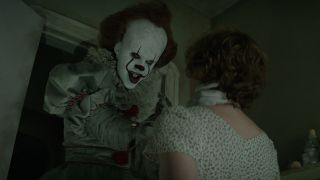
25. IT: Chapter One (2017)
Stephen King's IT is an ode to small town childhood and the loss of innocence, in the face of overwhelming supernatural evil. So anyone that tries to adapt that book needs to nail two halves of the same story: the younger years of Derry’s Losers Club and their adult incarnations coming back to fight evil once more.
IT: Chapter One absolutely nails the first half of that concept, as splitting the chronology into a more linear form was a fresh take on the material. The performances of the young cast, including Sophia Lillis, Jack Dylan Grazer, and Chosen Jacobs among their ranks, dig into the youthful characters even deeper than the impressive 1990 miniseries ever got to.
It also helped that director Andy Muschietti and writer Gary Dauberman had some fantastic bones to work off of, thanks to the work of Cary Joji Fukunaga’s variant of the project guiding the way. It wasn’t even guaranteed that we’d get a Chapter Two when the first half was released, but when we got to the end of Bill Skarsgård’s first outing of terror as Pennywise, you can bet the audience erupted into applause when the words “End of Chapter One” came onto the screen.
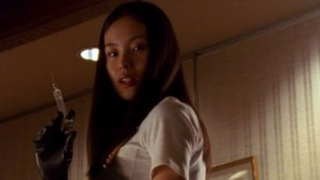
24. Audition (2000)
In theory, Audition feels like the wrong recipe for a horror movie, with a slow burn approach that can easily make new viewers forget what kind of movie they’re watching for long stretches. But my lord, does it earn all the terror it’s striving for by the end. A first-class effort from the prolific mad-scientist filmmaker Takashi Miike (Ichi the Killer), Audition’s uncomplicated story centers on widower Shigeharu (Ryo Ishibashi) whose friend sets up fake casting auditions with the goal of finding romance, thus putting him in the sights of the alluring and mysterious Asami (Eihi Shiina). Never is there doubt about Asami being an aberration, with a homelife and past hinting at monstrousness, but Miike and screenwriter Daisuke Tengan winningly lull viewers into anticipating a mild and/or traditional climax, and eventually bombard the senses with the complete opposite. Shiina steals the show and so much more, with fans knowing they’ll never hear the word “deeper” the same way again. At least until the next time Audition is on.
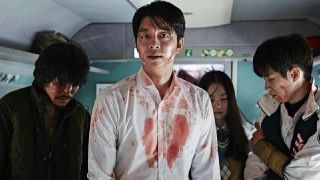
23. Train To Busan (2016)
Train to Busan is an excellent horror movie hailing from South Korean director Yeon Sang-ho, and is arguably the best zombie movie from any non-English-speaking country. It details the story of a man and his daughter aiming for a safe trip to Busan, only to find themselves having to survive a full-on zombie outbreak along with several other passengers.
From the excellent zombie make-up and designs to the monsters’ fast-paced transformations, Train to Busan is a true modern-day standout in the undead sub-genre. But what really makes this 2016 thriller pop is its heart, because despite all the stressful terror and dangerous situations these characters go through, it’s really about a father going through the motions of protecting his daughter, and that kind of love and devotion will always persist in the face of any threat. Not that such love will keep viewers from having zombie-infused nightmares.
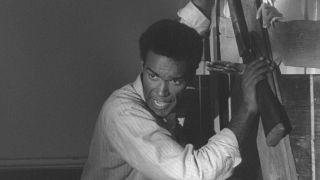
22. Night of the Living Dead (1968)
Starting a subgenre isn’t an easy feat, but it helped spark George A. Romero’s career as a filmmaker when he landed the seminal masterpiece Night of the Living Dead. What we know as the zombie movie found its modern start at this moment in time, with Romero and a scrappy crew of actors and crew members setting out to tell a macabre and downbeat tale of how the lines that divide us would be tested in times of extreme hardship.
Judith O’Dea and Duane Jones play the functional leads Barbara and Ben, two beacons of humanity we follow as the dead start to rise from the earth. As their ensemble of survivors start to quibble and quarrel in the face of seeming armageddon, we’re treated to a slice of humanity that’s threatened by something that hadn’t quite landed in the horror lexicon as big as it did in 1968.
The space race, and the Vietnam War to a certain extent, influenced George A. Romero’s Night of the Living Dead. When death and paranoia seemed unavoidable, Romero provided a frightening catharsis that still holds up to this day. Often imitated, but rarely equalled, this chiller will make you think twice about watching it in the dark.
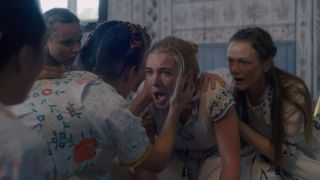
21. Midsommar (2019)
Filmmaker Ari Aster quickly established himself as an acclaimed horror director with his work on Hereditary, and fans were eager to embrace his genre follow-up Midsommar, which is a similarly disturbing and fascinating story that heads down unpredictably dark paths that inspire equally dark conversations among viewers. And it’s one that’s great for a re-watch or two, at least for those with stronger stomachs.
Midsommar follows Dani (Florence Pugh), who travels to a rural area of Sweden with her would-be ex- boyfriend (Jack Reynor) and his friends. They are there to visit for the midsummer festival, but become increasingly horrified by the rituals of the isolated commune that’s hosting them. While most horror movies rely on darkness to rank up tension, Midsommar stands out by doing the opposite; almost the entire movie is set during the day. Pugh gives an outstanding performance throughout its runtime, motivated by the trauma and grief of Dani’s backstory. Add in some ritual suicide and relationship issues with a dash of gonzo horniness, and what you get is a delightfully dread-soaked 148 minutes of folk-horror bliss. Plus that ending isn’t one that will be quickly forgotten, and not just because of its second life in meme-dom.
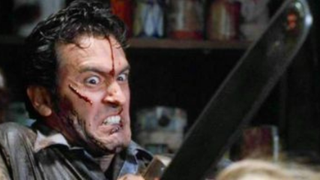
20. Evil Dead II (1987)
Even in a time where the term “re-quel” has gone mainstream, Evil Dead II still feels like both a unique and baffling follow-up film, and horror fans are all the more groovy for it! For various behind-the-scenes reasons, Sam Raimi’s second outing with Bruce Campbell’s highly adored Ash was a remixed take on the first film’s night-in-a-cabin premise (with some canonical differences), and essentially doubled-up on everything that made 1981’s The Evil Dead an instant fan-fave. What could possibly be better than Ash Williams fighting deadites? Ash fighting deadites as well as his own disembodied and possessed hand! And also Ash as a deadite! This 1987 classic is a rollicking good time from beginning to end, and delivers plenty of reasons why it’s rightfully earned its way onto myriad Best Horror lists since its release, but are any of those reasons more unequivocally badass than a protagonist who has a chainsaw for a hand? Not a chance, baby.
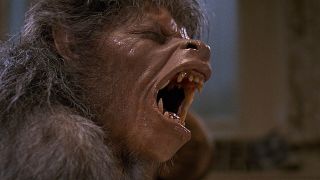
19. An American Werewolf In London (1981)
Though The Wolf Man’s Lon Chaney Jr. is undoubtedly the greatest werewolf actor out there, the greatest all-around movie centering on the furry beasts would be John Landis’ An American Werewolf in London, starring David Naughton and Griffin Dunne as David and Jack, two hitchhiking buddies abroad. While comedy-horror wasn’t exactly a new concept, many projects before the 1981 feature leaned largely on the comedy, and Landis aimed to go harder on the blood and scares.
American Werewolf probably would have been great with a hundred different make-up and effects artists, but it reaches “Best Ever” status because it handed those reins to the brilliant Rick Baker, who quickly became an industry leader and frequent Oscar winner. (Gremlins 2, Thriller, Videodrome, Men in Black are but a few of his standouts.) Even beyond the perfecto werewolf transformations, the film remains memorable for the main character’s friendship surviving their horrifying circumstances – despite one of them being undead and sporting highly gnarly wounds.
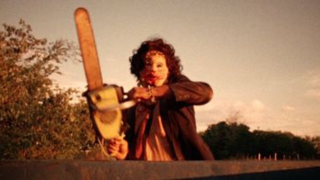
18. The Texas Chainsaw Massacre (1974)
There are quite a few horror movies that, without question, feel “nightmarish,” in the sense of being effectively frightening. However, not as many films actually feel like a nightmare by invoking a seemingly endless, surreal aura of dread, disgust, and pure fear. One of cinema’s most quintessential examples in this regard — despite, surprisingly, never showing a drop of blood — is The Texas Chain Saw Massacre.
Although falsely marketed as a horror movie based on a true story, writer/director Tobe Hooper’s film took inspiration from the infamous crimes of serial killer Ed Gein (per Parade), when crafting this story about a group of young road trippers who fall prey to a family of cannibals. As for how the main slasher Leatherface got his gas-powered, titular murder weapon: the late filmmaker recalled to Interview how he was trapped in a crowded department store, saw some chainsaws available, and imagined they would be a useful tool against the onslaught of customers.
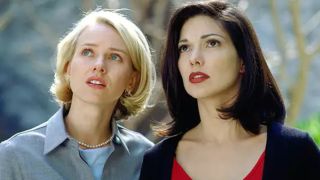
17. Mulholland Drive (2001)
Here’s what may be the scariest thing of all about Mulholland Drive—On first glance, you may not even realize that it’s a horror movie. In fact, many will likely tell you it’s not, since a vast majority of David Lynch’s films often veer into horrific territories. But unlike Eraserhead, Blue Velvet or Inland Empire, which dabble with horror elements, Mulholland Drive is the closest Lynch has ever gotten to making a pure horror film.
It’s the tone. Lynch employs dream-like elements in films like Twin Peaks: Fire Walk With Me and Lost Highway, but pretty much the entirety of Mulholland Drive feels like you’re just sitting through a nightmare. It all starts with a car crash, as its protagonist (Laura Elena Harring) becomes an amnesiac. When she meets an aspiring actress (Naomi Watts), we’re taken on a journey where a homeless person lives behind a diner, a cowboy has zero eyebrows, and a woman passes out on a stage because THERE IS NO BAND! It all makes for a dizzying experience that doesn’t become any clearer, no matter how many times you watch it.
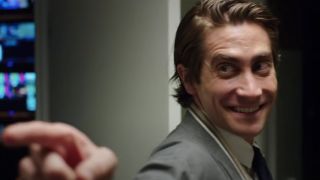
16. Nightcrawler (2014)
The horror genre isn’t always about the beasts we can’t reach out and touch on a daily basis. Sometimes, the most horrific thing is the overambitious young man who’ll sacrifice your life in the name of personal ambition, and do it with a smile. That’s the sort of fellow we’re dealing with in Dan Gilroy’s Nightcrawler, and his embodiment comes through Jake Gyllenhaal’s Louis Bloom.
We’re shown the seedier side of journalism as Lou falls into the career of a stringer, freelancing footage of crimes horrific and salacious to the highest bidder. Playing like a more horror-thriller tinged version of Network, Nightcrawler showcases a man with nothing to lose, not even his scruples. Jake Gyllenhaal’s electric performance as Mr. Bloom only nails this film all the deeper into the viewer’s mind, as you never know which side of Lou is going to present itself at any point.
“If it bleeds, it leads” is an old school adage of the news media, and Nightcrawler truly tests the boundaries of its ethos. And right at the heart of its twisted, darkly comic tale is Louis Bloom, one of the new embodiments of the American Dream in all of its horror. If you’re not afraid, you haven’t gotten to the end of the picture.
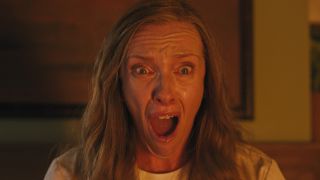
15. Hereditary (2018)
Hereditary is the kind of movie that will make you go to bed with the lights on. In Ari Aster’s feature directorial debut, we’re introduced to a family on the brink. However, they aren’t initially on the brink: it takes the loss of the matriarch’s mother for events to spiral out of control.
Death and grief have rarely been portrayed in such an ugly,mean-spirited way as it is in Hereditary. The closest comparison might be 1974’s Don’t Look Now, where the family is also left sort of adrift and empty after the death of a loved one. But while Don’t Look Now ratchets up the tension slowly, Hereditary hits you hard at every possible chance it gets. It all builds up to one of the most startling climaxes in modern cinema. We’re still reeling from this one.
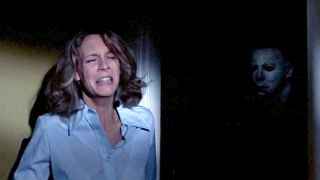
14. Halloween (1978)
The first entry in the seminal Halloween franchise remains the best (by far). This is probably because John Carpenter wasn’t looking to tease a sequel, or introduce a campy serial killer who could return every few years and strike fear in the hearts of a new crop of teenagers. No, with Halloween, Carpenter only concerned himself with unleashing The Shape on the unsuspecting suburban community of Haddonfield. Let the rest of the cards (or bodies) fall where they may.
Why does Halloween endure as a holiday tradition? Because the original movie dabbles in our basic fears. Someone is standing behind our slightly ajar closet door, and they are going to spring out the moment we look; or the man who is pursuing us can take our biggest hit, but get up and keep marching after us. That’s terrifying. But the counterbalance to Michael Myers is what really helps Halloween stand apart, because Jamie Lee Curtis’ Laurie Strode is the prototypical Final Girl and proved beyond a shadow of a doubt that all of our monsters – no matter their shape or size – could be defeated, again and again and again.
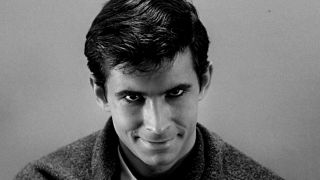
13. Psycho (1960)
It’s unlikely that Alfred Hitchcock realized he’d be making one of the most influential horror thrillers of all time when he brought Robert Bloch’s 1959 novel to the big screen, but Psycho is indeed a legendary film for various reasons. First is Janet Leigh’s iconic shower death, which horrified audiences while defying expectations with its mid-film arrival. Then we have Anthony Perkins’ career-defining role as Norman Bates, a mentally disturbed hotel proprietor who never escaped the domineering clutches of his mother, and chose not to escape the clutches of that same mother’s brassieres.
Because of course, another one of Psycho’s everlasting treasures is the truth about the Bates family, as it were – which, like The Texas Chain Saw Massacre, was in part based on the infamously depraved serial killer Ed Gein, which is what helps steer the film into “classic horror” territory despite the main story revolving around a classic stolen money MacGuffin. And it just wouldn’t be the Psycho we all know and love without the unforgettable strings of composer Bernard Hermann and his soundtrack dubbed “The Murder.”
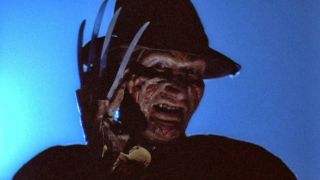
12. A Nightmare On Elm Street (1984)
Whether a horror expert or just a casual fan, just about any filmgoer can likely name Freddy Krueger as the bladed-glove-wearing iconic villain of A Nightmare on Elm Street, a franchise that currently spans nine movies. But few would argue that the 1984 original is the most classic of the bunch. Written and directed by Wes Craven, it is both a slasher and a psychological thriller as teens are hunted in their dreams, where the deadly consequences also play out in the real world. Some of the most spectacularly gory deaths of the 1980s easily set the stage for Freddy Krueger’s future ranks as an A+ movie monster, and the bathtub sequence alone may be enough for viewers to want to stay awake until the jump rope song is no longer stuck in their heads. “One, two, Freddy’s coming for you…”
A Nightmare on Elm Street was also the film debut for Johnny Depp, still several years off from starring turns in Edward Scissorhands and 21 Jump Street. And it was also Robert Englund’s first and freakiest appearance as Freddy Krueger, cementing himself as a legend of horror for years to come, with Heather Langenkamp as this franchise’s most ideal scream queen.
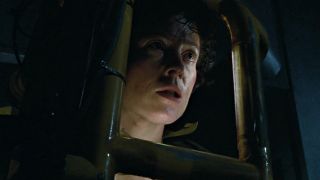
11. Aliens (1986)
Early in his career, James Cameron wasted no time earning the love and devotion of genre fans. After all, his big break came in 1984 with the release of The Terminator, and his big follow-up act was creating what is rightfully considered one of the greatest sequels of all time: 1986’s Aliens.
Building on Ridley Scott’s haunted house in space (more on that in a moment), Cameron took a more action-movie approach to his story about xenomorphs – but the inclusion of space marines most definitely doesn’t do anything to undercut the terror of the eponymous creatures, with scary highlights including the early nest attack and the scene with the facehuggers in the lab. This is also, of course, the movie where Sigourney Weaver’s Ellen Ripley becomes a true big screen legend, her maternal badassness reaching a perfect climax in the film’s big finale where she straps into a power loader and does battle with the alien queen.
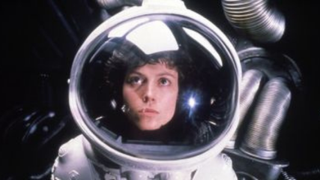
10. Alien (1979)
One of modern cinema’s greatest debates – Alien vs. Aliens – was considered in the construction of this ranking, and fittingly, it’s the scarier of the two movies that has been placed one spot ahead of the other (perhaps Aliens will have the edge when we eventually get around to comparing the best sci-fi films of all time). Director Ridley Scott’s beloved seminal film in the Xenomorph-centric franchise is a magnificent accomplishment of closed-space terror outfitted with what is unquestionably one of the greatest taglines in cinematic history: "In space, no one can hear you scream."
H.R. Giger’s designs for both the xenomorph and the so-called facehugger are the perfect blend of elegant and repulsive, and the terror that they unleash on the USCSS Nostromo is so powerful that it still gets to you even after your thirtieth viewing. And, of course, we can’t forget that this is where we get to witness the origins of Ellen Ripley, who will forever be known as one of the great original final girls.
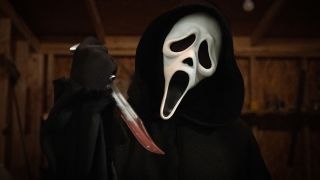
9. Scream (1996)
Where to start with Scream? Late horror icon Wes Craven changed the film world forever with his 1996 hit, helping to bring new life to a suffering genre. The movie’s mixture of comedy and horror has been emulated countless times over the years, as has the idea of poking fun at the state of the horror genre. It all started with Scream. The film is is set in Woodsboro, California, and follows as high school students begin being brutally butchered by a masked killer known as Ghostface. The slasher shocked audiences with its violence, and for killing off Drew Barrymore’s Casey Becker in its iconic opening sequence. After that the focus pivots to Neve Campbell’s final girl Sidney Prescott, who is grieving her mother Maureen being killed exactly one year earlier.
Just about everything in the first Scream movie is lionized at this point. Performances by the cast are all stellar, especially Matthew Lillard, Rose McGowan, and Courteney Cox. Ghostface is terrifying, but there are also plenty of funny moments along the way. And if Ghostface were to ask me, my answer for my favorite scary movie is clear: Scream.
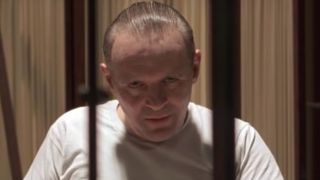
8. The Silence of the Lambs (1991)
The Silence Of The Lambs is best remembered for its two brilliant Oscar-winning acting performances from Anthony Hopkins and Jodie Foster and rightfully so. No praise is too effusive for his deeply unnerving, manipulative and oddly charming Dr. Hannibal Lecter and her uncertain-yet-relentless Clarice Starling. They’re both amongst the greatest characters the horror genre has ever given us, but that level of success is only possible if other people crush their jobs too. And so many people involved in this movie contribute some of the best work of their careers.
Director Jonathan Demme is so thoughtful about what to show and what not to show, when to linger and when to move on. His artistic choices create an undercurrent of anxious determination in Clarice and an aura of mysterious invincibility in Hannibal. Persistent close-up shots from cinematographer Tak Fuijimoto help too, as does the script from Ted Tally – which has so much to say about misogyny, feminism, class and abuse but rarely comments on it directly. It all works: the music, the costuming, the set design, all the supporting performances and everything else. It all contributes to the same moody and wholly original vision, which helps turn those all-time lead acting performances into an all-time great movie.
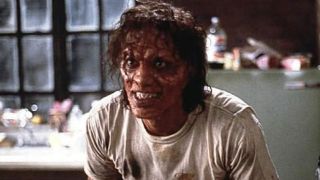
7. The Fly (1986)
In the history of horror movie taglines, “Be Afraid. Be Very Afraid” might just be at the very top of the heap. And if it’s not, then it’s right beside Alien’s, “In space no one can hear you scream.” Thankfully, David Cronenberg’s The Fly, which is a loose remake of the 1958 movie of the same name, lives up the hype. The story concerns a scientist, played by Jeff Goldblum, who is trying to create a teleportation device. While testing it, his DNA gets spliced with a fly’s that flew into the machine. The result is probably the purest form of Cronenberg’s own particular brand of body horror, as this movie is utterly disgusting to watch. Jeff Goldblum’s character is literally falling apart as he transforms into the hideous “Brundlefly” as he calls himself.
The metamorphosis itself is grotesque, but what makes this a horror movie for the ages is Geena Davis, who plays the character’s girlfriend. We’re right there with her as she witnesses somebody who she cares about deteriorating and becoming something else, and it’s outright uncomfortable to watch, which is what makes this such a fantastic movie in the first place.
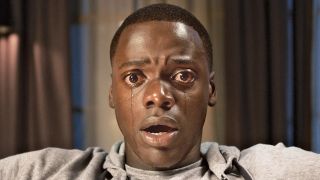
6. Get Out (2017)
Is Jordan Peele’s Get Out the greatest directorial debut of all time? Well, maybe not (we do live in a world where Citizen Kane exists, after all), but even if it isn’t, it’s definitely up there with a select few other directors who made a great movie on their very first try. The story has a red-hot plot. A white woman (Allison Williams) brings her Black boyfriend (Daniel Kaluuya) to meet her parents, and everything just seems… off.
Sure, the parents seem like they mean well, but there is just something that you can sense is simmering beneath the surface. And, once it’s out in the open, it’s really out in the open. What makes Get Out truly special though – other than the fact that it’s one of only six other horror movies to ever be nominated for Best Picture) – is that it’s not just any one thing. Yes, it’s about race, but also about class, gender, and identity. All of that is wrapped up in a movie that is part creepfest/part commentary, and also with a dash of humor. Get Out is a horror movie for the ages.
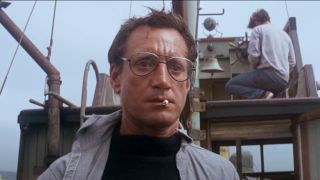
5. Jaws (1975)
From thrilling adventures, to alien invasions, to heart-wrenching dramas, there is nothing that Steven Spielberg can’t do – and that includes creating one of the greatest horror films of all time. Based on the novel of the same name by Peter Benchley, Jaws is a simple story about a beach community terrorized by a man-eating great white shark, but there are few more influential, iconic, and beloved movies of all time.
Jaws reels you in from the very first scene with a vignette about an ill-fated skinny dipper who finds herself tossed around and torn apart, and through the first two acts, it evolves as a genius execution of psychological terror (a side effect of the filmmakers not being able to get the production’s mechanical shark to work consistently). Brody, Quint and Hooper, played by Roy Scheider, Robert Shaw, and Richard Dreyfuss, make one of the best trios in cinematic history, and from “We’re going to need a bigger boat” to “Smile, you son of a bitch,” the third act is legendary.
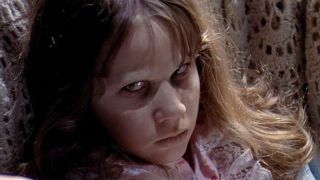
4. The Exorcist (1973)
Fifty years ago, a film was released that would serve as the benchmark for an entire ongoing subcategory of horror known as the “demonic possession movie” or “exorcism movie” genre. While countless filmmakers have tried — including David Gordon Green with his own 2023 legacy sequel to the classic, The Exorcist: Believer — none have managed to achieve the same visceral shock, indelible frights, and thought-provoking questions of belief quite like the original classic that started it all, The Exorcist.
Intriguingly, the late director William Friedkin never saw this story — in which an actor (Ellen Burstyn) seeks the help of a priest (Max Von Sydow) to save her 12-year-old daughter (Linda Blair) from the malevolent presence that has taken over her — as a “horror movie,” but intended to make his adaptation of William Peter Blatty’s novel a commentary on “the mystery of faith.” Perhaps that — in addition to its brilliant acting, haunting makeup effects, and allegedly fact-based origins — is the real secret to The Exorcist’s lasting success five decades running.
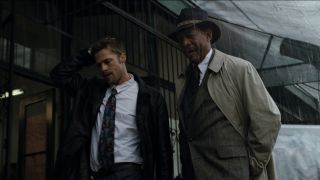
3. Se7en (1995)
Few movies have a way of souring an otherwise pleasant day the way that any five-minute stretch of Se7en can in its 127-minute runtime, which is a badge of honor adorned by what is arguably the most intriguingly bleak accomplishment in the acclaimed career of David Fincher. Arguments have been had over whether Se7en truly falls under the horror umbrella – and had it not been Fincher’s direct follow-up to his rage-inducing experience with Alien 3 or had it been released with the studio’s preferred ending instead of the actual conclusion, those arguments might hold more water. (Presumably rain water.)
Even if Brad Pitt’s scrappy cop Mills and Morgan Freeman’s retiring detective Somerset never catch John Doe in the act with his morally twisted and sadistic human experiments, the damage done to the victims and viewers is on par with the majority of the genre’s most noteworthy antagonists. The seven deadly sins M.O. combined with the puzzle-esque nature of Doe’s clues and crimes directly influenced many other horror films in its wake (looking at you, Saw), and it raises the stakes far above the average serial killer tale. Meanwhile, the grounded relationship between Somerset and Mills’ lonely wife Tracy adds a surprising amount of emotional heft thanks to Freeman and Gwyneth Paltrow’s perfect chemistry, which allows the ending’s hammer to slam down as hard as humanly possible. Not much about Se7en can be considered “fun,” but everything about it is excellent.
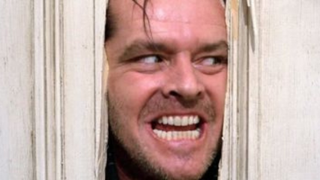
2. The Shining (1980)
In the late 1970s, Stanley Kubrick needed to make a hit movie. His Hollywood reputation was in trouble following the poor box office performance of Barry Lyndon, and he needed a film that would have greater audience appeal. He ended up with a copy of Stephen King’s The Shining during his search for a new project, and the inspiration he got from reading the novel led him to create one of the all-time greatest experiences in psychological terror that has ever graced the big screen.
Any King fan will tell you that the adaptation is vastly different than the source material (and it’s the source of on-going controversy because of this), but Stanley Kubrick’s The Shining is gloriously its own thing – tracing Jack Torrance’s descent into madness as he and his family serve as caretakers for a haunted Overlook Hotel in the Rocky Mountains. The performances by Jack Nicholson, Shelley Duvall and Danny Lloyd are phenomenal, and everything in the design is iconic, from the carpet patterns to the groundbreaking tracking shots. There are probably few films in history that are as influential, as you could likely reconstruct the entire thing using clips from other features and TV shows. It’s a special piece of cinematic art in addition to being one of the greatest horror movies of all time.
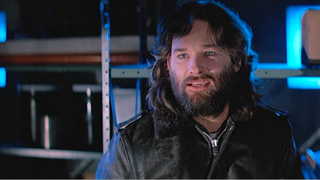
1. The Thing (1982)
What does the perfect horror movie look like? When you’re talking about John Carpenter’s timeless classic The Thing, it looks like whatever it wants. The second cinematic adaptation of John W. Campbell Jr.’s novella Who Goes There, this 1981 behemoth tells an alien story far from the heartfelt emotions of E.T. and brainy wonder of Close Encounters, where the only thing certain to survive out in the frozen abyss of Antarctica is rampant paranoia.
With a cast of talents led by Kurt Russell, Wilford Brimley, Keith David and more, The Thing centers on a team of researchers who discover their station is located near the long-ago crash site of something not of this world. And once the group identifies the existence of said threat, all bets are off as the thriller (snow)-plows forward from one pulse-raising sequence to the next, with the already antsy crew having to figure out what they’re dealing with at the same time the shapeshifting abomination is assimilating to its surroundings. Much praise rightfully goes to Carpenter, Russell and the rest of the cast and crew for their stellar efforts, but the stomach-churning, slime-covered creature designs and special effects from Rob Bottin (Se7en, Total Recall) — as well as Stan Winston’s collaboration on the gag-worthy dog-monster — help boost The Thing to the multi-headed vertex of the genre. And since truly great movies don’t flub their landings, it only makes sense that this is one of the most debated and celebrated conclusions in all of horror.
And that wraps up our list of the best horror movies of all time. Did your favorites make the list?

Nick is a Cajun Country native and an Assistant Managing Editor with a focus on TV and features. His humble origin story with CinemaBlend began all the way back in the pre-streaming era, circa 2009, as a freelancing DVD reviewer and TV recapper. Nick leapfrogged over to the small screen to cover more and more television news and interviews, eventually taking over the section for the current era and covering topics like Yellowstone, The Walking Dead and horror. Born in Louisiana and currently living in Texas — Who Dat Nation over America’s Team all day, all night — Nick spent several years in the hospitality industry, and also worked as a 911 operator. If you ever happened to hear his music or read his comics/short stories, you have his sympathy.
Most Popular





